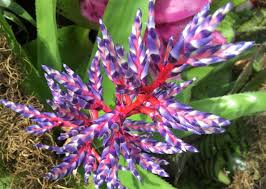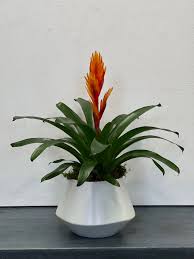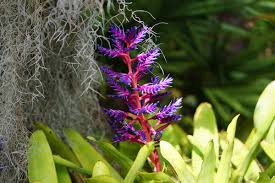The Bromeliaceae family, are more commonly known as bromeliads. These captivating flowers are nature’s colorful masterpieces, adorning the landscapes of tropical regions around the globe. From the lush rainforests of South America to the sun-kissed islands of the Caribbean, bromeliads have captivated the hearts of plant enthusiasts and casual observers alike.
Bromeliad flowers come in an astounding array of shapes, sizes, and colors, showcasing Mother Nature’s artistic flair. These beauties range from delicate, petite blossoms to grand, imposing inflorescences that demand attention. Some bromeliads even bear flowers that last for months, ensuring a continuous display of natural splendor.
One of the most remarkable features of bromeliad flowers is their unique method of growth. Unlike many other flowering plants, bromeliads are epiphytes, meaning they can thrive without soil. Instead, they attach themselves to trees or rocks, drawing nutrients and moisture from the air and surrounding environment. This adaptive ability allows bromeliads to flourish in various habitats, making them a versatile and resilient plant family.
The colors of bromeliad flowers are a true feast for the eyes. Brilliant shades of red, pink, orange, yellow, and purple splash across their petals, attracting pollinators like hummingbirds and butterflies. These vivid hues not only serve as a magnet for wildlife but also bring life and vibrancy to any garden or living space.
Beyond their stunning beauty, bromeliads play an essential ecological role in their native environments. Their rosette-shaped leaves form natural reservoirs that collect rainwater and fallen debris, creating mini-ecosystems that provide a home for a wide array of organisms. From tiny insects to tree frogs, numerous creatures depend on bromeliads for survival, making them valuable players in their ecosystems.
In addition to their visual allure and ecological significance, bromeliads have also found their way into various cultural traditions and practices. Some indigenous communities have used bromeliads for medicinal purposes, while others weave their fibers into baskets and clothing. The bromeliad’s cultural importance is a testament to the deep connections between humanity and the natural world.
Caring for bromeliad flowers can be a joyful and rewarding experience. These low-maintenance plants prefer bright, indirect light and require occasional watering into their central rosettes. Their ability to thrive in indoor environments makes them a popular choice for indoor gardening enthusiasts, brightening up homes and offices with their charming presence.
In addition, bromeliad flowers, part of the Bromeliaceae family, represent an extraordinary chapter in the natural world’s rich tapestry. Their captivating beauty, diverse colors, and unique growth habits make them a standout among tropical plants. Whether they are flourishing in the wild or adding elegance to indoor spaces, bromeliads never fail to enchant and inspire those fortunate enough to witness their floral splendor. So, next time you encounter a bromeliad flower, take a moment to appreciate this wonder of nature’s creativity and resilience.
Read Also: Pincushion Flowers (Scabiosa Spp): Complete Growing and Care Guide
History and Significance of Bromeliad Flowers

The history of bromeliad flowers dates back thousands of years, intertwined with the rich cultural heritage of the regions they naturally inhabit. Native to the tropical Americas, these fascinating plants have been an integral part of the lives of indigenous communities, who recognized their significance and harnessed their unique properties for various purposes.
Ancient civilizations, such as the Aztecs and the Mayans, revered bromeliads for their mystical qualities and used them in religious ceremonies. The striking beauty and resilience of these flowers inspired legends and folklore, with tales passed down through generations, celebrating their role in the natural world.
Beyond their cultural significance, bromeliads have also contributed to scientific discoveries. In the 18th and 19th centuries, explorers and botanists marveled at the diversity of bromeliad species during their expeditions to the Americas. The renowned naturalist Alexander von Humboldt was among the first to document these plants extensively, sparking curiosity and interest in botany worldwide.
During the 19th century, bromeliads gained popularity in Europe and North America as exotic ornamental plants. Collectors and horticulturists were captivated by their striking beauty and unique growth habits, leading to the establishment of specialized collections and greenhouses dedicated to these fascinating flora.
Today, bromeliads continue to play a vital role in horticulture and gardening. Hybridization and breeding programs have led to the development of countless cultivars, further enhancing their visual appeal and adaptability. Gardeners and enthusiasts worldwide cherish bromeliads for their versatility, ease of care, and ability to add a touch of the exotic to any landscape or indoor space.
The significance of bromeliad flowers extends beyond their aesthetic appeal. As epiphytes, they have ecological importance in their native habitats. In tropical rainforests, bromeliads create mini-ecosystems within their rosettes, providing shelter, water, and nutrients for various organisms. Frogs, insects, and even small mammals have been known to call bromeliads their home, highlighting their critical role in supporting biodiversity.
Moreover, bromeliads are considered indicator plants in certain ecosystems. Their sensitivity to changes in environmental conditions, such as air quality and temperature, makes them valuable bioindicators, signaling shifts in the health of their ecosystems. Monitoring the well-being of bromeliad populations can provide valuable insights into the overall ecological health of a region.
Beyond their ecological significance, bromeliad flowers continue to inspire artists, writers, and nature enthusiasts. Painters have captured their vibrant colors on canvases, writers have woven stories around their enchanting beauty, and photographers have sought to capture their allure through lenses. These plants have a unique ability to evoke emotions and a sense of wonder, drawing people closer to the wonders of the natural world.
However, the history and significance of bromeliad flowers are deeply rooted in both human culture and the natural world. From ancient rituals and folklore to scientific exploration and contemporary horticulture, these captivating flowers have left an indelible mark on human history. Their beauty, resilience, and ecological importance continue to captivate our hearts and minds, serving as a reminder of the intrinsic connection between humanity and the diverse wonders of the plant kingdom.
Uses of the Bromeliad Flowers

Bromeliad flowers and plants have several practical and cultural uses that extend beyond their aesthetic appeal. Let’s explore some of the key uses of bromeliads:
1. Ornamental Plants: One of the primary uses of bromeliads is as ornamental plants. With their striking and vibrant flowers, unique shapes, and diverse colors, bromeliads make stunning additions to gardens, landscapes, and indoor spaces. They add a touch of the exotic and tropical flair to any setting, enhancing the visual appeal of the surroundings.
2. Indoor Decor: Many bromeliad species are well-suited for indoor cultivation due to their adaptability to varying light conditions. They thrive as houseplants, making them popular choices for interior decoration. Bromeliads can be potted individually or grouped together to create eye-catching displays in homes, offices, and public spaces.
3. Air Purification: Bromeliads, like other houseplants, help purify the air by absorbing toxins and releasing oxygen during photosynthesis. They can contribute to creating a healthier indoor environment by reducing the levels of harmful pollutants and improving air quality.
4. Ecological Restoration: In certain regions, bromeliads play a crucial role in ecological restoration projects. Their ability to grow on tree branches or rocky surfaces makes them valuable for stabilizing soil, preventing erosion, and assisting in the regeneration of degraded ecosystems.
5. Wildlife Habitat: As epiphytes, bromeliads create small ecosystems within their rosettes, providing habitats for a variety of organisms. In their native environments, these plants offer shelter, food, and breeding sites for insects, frogs, birds, and other wildlife, contributing to biodiversity conservation.
6. Traditional Medicine: In some cultures, bromeliads have been used for medicinal purposes. Certain species are believed to have healing properties and have been traditionally used to treat various ailments. However, it is essential to exercise caution and consult with medical experts before using bromeliads for medicinal purposes, as some species may be toxic.
7. Fiber and Craft Use: The leaves of some bromeliad species contain fibers that have been used to craft baskets, mats, and other artisanal items in certain indigenous communities. These fibers are durable and can be woven into intricate designs.
8. Floral Arrangements: Bromeliad flowers are often used in floral arrangements and bouquets due to their long-lasting nature. Their vibrant colors and unique shapes add a distinctive touch to flower displays for weddings, events, and celebrations.
9. Biological Research: Bromeliads have attracted the attention of scientists and researchers for their intriguing growth habits and ecological interactions. They serve as valuable subjects for studies in plant biology, ecology, and evolutionary biology.
In addition, bromeliad flowers and plants are not only admired for their beauty but also valued for their practical uses and cultural significance. From enhancing the aesthetics of living spaces to contributing to ecological restoration efforts and even traditional medicine, bromeliads continue to leave a lasting impression on various aspects of human life and the natural world.
Read Also: Economic Importance, Uses, and By-Products of Mushroom Gills
Complete Growing Guide of Bromeliad Flowers

Bromeliads are delightful and low-maintenance plants that can thrive indoors and outdoors, adding a touch of tropical beauty to your surroundings. Whether you’re a seasoned gardener or a beginner, follow this comprehensive growing guide to ensure your bromeliad flowers flourish:
1. Selecting the Right Bromeliad: There are numerous bromeliad species and cultivars to choose from. Look for healthy plants with vibrant foliage and, if applicable, colorful bracts or flowers. Consider the lighting conditions of your home or garden, as some bromeliads prefer brighter light, while others do well in indirect light.
2. Light Requirements: Most bromeliads prefer bright, indirect light. Place them near a window with filtered sunlight, or in areas with bright but not direct sunlight. Avoid exposing them to intense, direct sunlight, as it can scorch their leaves.
3. Temperature and Humidity: Bromeliads are tropical plants and thrive in warm temperatures. They prefer temperatures between 60°F to 80°F (15°C to 27°C). Higher humidity levels are beneficial, so misting the leaves occasionally or placing a humidifier nearby can help create an ideal environment.
4. Watering: Bromeliads have a unique water-capturing feature, known as the central rosette. Water should be poured directly into this rosette, keeping it filled at all times. Ensure the water is clean, free from chlorine, and never allow it to become stagnant. The frequency of watering depends on the species and environmental conditions, but a general guideline is to water every 1-2 weeks.
5. Soil and Potting: Bromeliads are epiphytes, meaning they don’t require soil to grow. Instead, they can be potted in a well-draining mix, such as a combination of orchid bark, perlite, and peat moss. Select a pot with good drainage holes to prevent waterlogging.
6. Fertilization: Bromeliads are relatively light feeders. Use a diluted, balanced liquid fertilizer once a month during the growing season (spring and summer). Avoid fertilizing during the winter months when the plant is in its dormant phase.
7. Air Circulation: Adequate air circulation is crucial for bromeliads. Make sure they have space around them and are not crowded by other plants.
8. Pruning: Remove any dead or brown leaves from the plant to keep it looking tidy and healthy. Trim spent flower stalks after they have finished blooming, cutting them near the base.
9. Repotting: Bromeliads generally don’t require frequent repotting. Repot only when the plant outgrows its container or when the potting mix becomes depleted. Spring is an ideal time for repotting.
10. Pests and Diseases: Bromeliads are relatively resistant to pests and diseases. However, keep an eye out for common issues like mealybugs or scale insects. If detected, treat with a gentle insecticidal soap or neem oil spray.
11. Flowering and Blooming: Bromeliad flowers are long-lasting and can remain vibrant for several weeks to months, depending on the species. After flowering, the mother plant may produce offshoots or “pups.” These can be separated once they reach about one-third the size of the mother plant and potted individually.
Remember, each bromeliad species may have specific care requirements, so it’s always beneficial to research the particular type you have. With a little attention and love, your bromeliad flowers will reward you with their striking beauty and make a stunning addition to your indoor or outdoor space.
Read Also: 10 Creative DIY Shelving Ideas to Organize Your Space in Style
